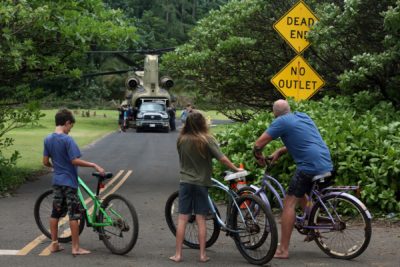Strain of COVID-19 Affecting Mental Health of Kauai Residents
More than half (57 percent) of Kaua‘i households have at least one person living in their home who has lost their job as a result of the pandemic, and the resulting economic strain is affecting the mental health of Garden Island residents.
These findings were revealed in a Community Assessment for Public Health Emergency Response (CASPER) survey conducted in April by the Hawai‘i Department of Health’s Kaua‘i District Health Office to assess the impact of the COVID-19 pandemic.
Although Kaua‘i households are relatively stable in terms of housing, food, and other basic necessities, one third are very concerned or somewhat concerned about their ability to pay the following month’s rent or mortgage. These concerns are being exacerbated by the approaching termination dates of state and federal financial assistance programs, including the Federal Pandemic Unemployment Compensation program, the Pandemic Unemployment Assistance program, moratoriums on rental evictions, forbearance on government-guaranteed mortgages, and moratoriums on utility shutoffs.
“The 2020 Kaua‘i CASPER collected invaluable data that we can use to inform state and county emergency response operations and enable the Department of Health and Kaua‘i County to better meet the community health and other resource needs over the next few months,” said Dr. Janet Berreman, Kaua‘i District Health Officer.
Nearly one-third of households (32 percent) surveyed indicated they are experiencing emotional distress related to the pandemic. Of those, 21 percent did not know where to seek help if they need it. Most Kaua‘i households seem to be weathering the pandemic moderately well, with 60 percent reporting a low stress level. However, 34 percent reported a medium level of stress and 5 percent reported their stress level as high, near the breaking point.
Mental health resources are limited on Kaua‘i, where relatively high rates of suicide and behavioral health needs are a long-standing problem, as in many rural counties. Kaua‘i suffered four suicide deaths in the beginning of May. The report recommends the health department, mental health service providers, and the county continue to work together to improve access to culturally appropriate, affordable behavioral health services, including non-traditional approaches such as telehealth visits.
“The impact of the pandemic on mental health may continue for months and potentially years,” Dr. Berreman said.
Financial Assistance Program
The report recommends using CARES Act funds for direct assistance programs such as rental assistance, small business loans, child care programs, and behavioral health programs. As the response shifts from disease control to the provision of much-needed resources and support systems, the state should consider the development of a temporary workforce program focused on infrastructure improvements and conservation projects for individuals who may not be rehired because of a diminished visitor industry.
Health Impact
A third of Kaua‘i households (34 percent) have at least one member at high risk of severe disease if infected with COVID-19. To mitigate risk of infection, the report recommends the state consider targeted food and essential item delivery programs to high-risk individuals, including those over 70 years of age and those with serious underlying conditions, while emphasizing the safer-at-home recommendations.
Less than 5 percent of households reported that a member had been tested for COVID-19; none of those received a positive result. Only 4.3 percent of households indicated that a member had been sick with what they thought was COVID-19 but didn’t get tested.
This data suggests that residents know when and how to get tested for COVID-19 and explains why there have been no new cases on Kaua‘i since mid-April. As restrictions are lifted and businesses start to re-open, the Department of Health will continue to emphasize the importance of staying home when sick and how and when to get tested. The ability to identify, isolate, trace, and quarantine close contacts is essential to ensuring a second wave of infections doesn’t overwhelm the health care system. Additional capacity for contact tracing and disease investigation is under continuing development with Department of Health staff and Kaua‘i Medical Reserve Corps volunteers. Current capacity of more than 50 contact tracers exceeds the nationally recommended standard of 30 tracers per 100,000 population.
Survey Methodology
Door-to-door surveys were conducted in 30 randomly selected census tracts within the county. Survey teams were comprised of DOH staff with support from the Kaua‘i Emergency Management Agency, Kaua‘i Medical Reserve Corps, and the American Red Cross. Selected households were asked about their knowledge, attitudes, and practices related to COVID-19, as well as the financial and mental health impacts on households.
The CASPER survey methodology was developed by the Centers for Disease Control and Prevention (CDC) as a way to rapidly assess the health and other resource needs of a community after a disaster.
#rebuildingtravel




